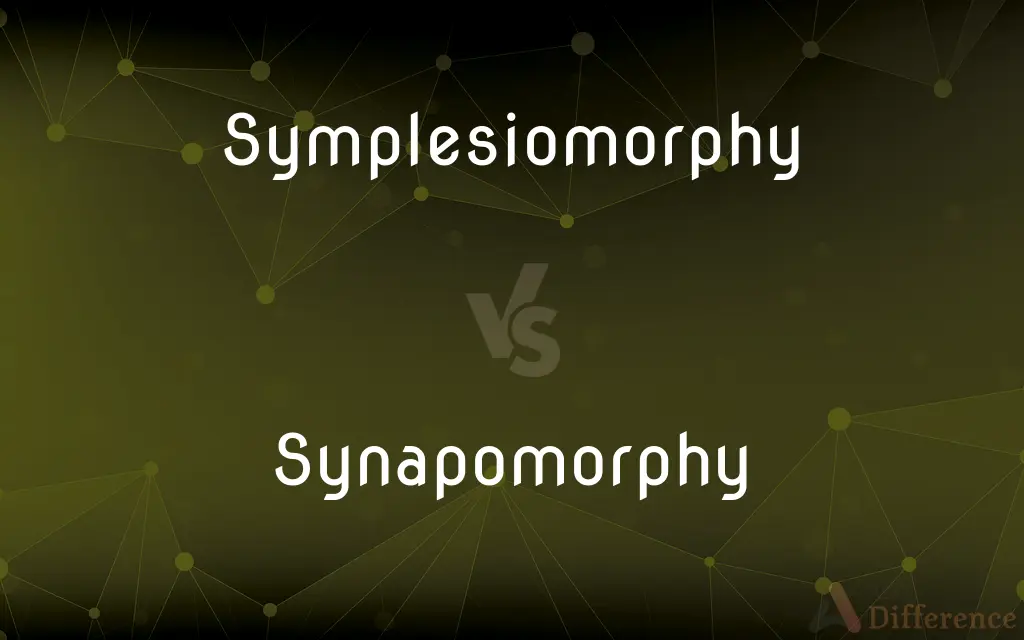Symplesiomorphy vs. Synapomorphy — What's the Difference?
By Maham Liaqat & Fiza Rafique — Updated on March 20, 2024
Symplesiomorphy refers to a shared ancestral trait found in two or more taxa that stems from their distant common ancestor, while synapomorphy denotes a shared derived trait that is found in two or more taxa.

Difference Between Symplesiomorphy and Synapomorphy
Table of Contents
ADVERTISEMENT
Key Differences
Symplesiomorphy involves characteristics that are inherited from a distant common ancestor shared by multiple species, indicating a more ancient evolutionary lineage. These traits are basic and often found across a wider range of taxa, reflecting a fundamental level of biological organization. On the other hand, synapomorphy represents traits that have evolved more recently, distinguishing a specific group of organisms from others by reflecting their most recent common ancestor. These derived traits are crucial for understanding evolutionary relationships and for the classification of organisms into more closely related groups, known as clades.
While symplesiomorphies are important for identifying broad evolutionary patterns and the basic structure of life, synapomorphies are more useful for constructing phylogenetic trees and understanding the specific evolutionary paths that lead to the current diversity of life. The presence of a symplesiomorphy in different species does not necessarily indicate a close evolutionary relationship, as these traits are ancient and widespread. Conversely, synapomorphies imply a closer kinship and are key to defining more precise evolutionary relationships among organisms.
Identifying symplesiomorphic traits helps scientists recognize the foundational characteristics shared among broader groups, offering insights into the early stages of evolutionary development. Synapomorphies, however, are pivotal in distinguishing between more closely related lineages, aiding in the detailed reconstruction of the tree of life. They help clarify which species diverged from common ancestors at specific points in evolutionary history, thus providing a clearer picture of biodiversity.
The distinction between symplesiomorphy and synapomorphy is fundamental in evolutionary biology, particularly in the field of cladistics, which focuses on classifying organisms based on shared derived characteristics. While both types of traits are vital for understanding the evolutionary history of life, synapomorphies are especially valued for their role in identifying and supporting the existence of evolutionary relationships among closely related species or taxa.
Comparison Chart
Definition
Shared ancestral trait
Shared derived trait
ADVERTISEMENT
Origin
Distant common ancestor
Most recent common ancestor
Evolutionary Level
More ancient, basic
More recent, specialized
Indication
Broad evolutionary patterns
Close evolutionary relationships
Usage in Phylogeny
Identifies broad groups
Distinguishes more closely related groups
Importance
Reflects fundamental biological organization
Crucial for constructing phylogenetic trees
Compare with Definitions
Symplesiomorphy
Basic characteristic.
Having a backbone is a symplesiomorphic trait among vertebrates.
Synapomorphy
Clarifies biodiversity.
The amniotic egg is a synapomorphy among amniotes.
Symplesiomorphy
Ancestral trait.
The presence of vertebrae in mammals and birds is a symplesiomorphy.
Synapomorphy
Indicates close relationships.
Flowering is a synapomorphy identifying angiosperms.
Symplesiomorphy
Shared among taxa.
Symplesiomorphies identify broad groups like vertebrates.
Synapomorphy
Recent evolutionary change.
Opposable thumbs are a synapomorphy in primates.
Symplesiomorphy
Foundation of biology.
Cellular structures in animals and plants are symplesiomorphic.
Synapomorphy
Derived trait.
The presence of feathers is a synapomorphy unique to birds.
Symplesiomorphy
Reflects early evolution.
Gills in fish and larval amphibians are a symplesiomorphy.
Synapomorphy
Used in phylogenetics.
Bipedalism is a synapomorphy distinguishing hominids.
Symplesiomorphy
The possession by two or more organisms or taxa of a shared primitive or ancestral character not exclusive to or characteristic of them in particular; the shared character itself.
Synapomorphy
An evolved character or trait that is shared by two or more taxonomic groups and is considered to have originated in their common ancestor. Hair is synapomorphic for marsupials, primates, and all other taxa that are grouped together in the class Mammalia.
Symplesiomorphy
(cladistics) An ancestral trait shared by two or more taxa.
Synapomorphy
(cladistics) A derived trait that is shared by two or more taxa of shared ancestry.
Common Curiosities
How do synapomorphies aid in understanding evolutionary relationships?
By indicating shared derived traits, they clarify closer evolutionary kinships.
What role do symplesiomorphies play in evolutionary biology?
They help identify basic and ancient characteristics shared among broader groups.
Why are synapomorphies more valuable in cladistics?
They are crucial for constructing accurate phylogenetic trees and distinguishing closely related groups.
Can symplesiomorphies mislead evolutionary analysis?
Yes, if not carefully analyzed, they can suggest incorrect evolutionary relationships due to their broad and ancient nature.
How does the discovery of synapomorphies affect classification?
It can lead to reclassification or refinement of taxonomic groups based on closer evolutionary relationships.
What impact do new discoveries have on understanding symplesiomorphies and synapomorphies?
They can refine our understanding of evolutionary relationships and lead to adjustments in the phylogenetic classification.
Can a trait be both a symplesiomorphy and a synapomorphy?
A trait's classification depends on the taxonomic context; it may be a symplesiomorphy at one level and a synapomorphy at another.
How do symplesiomorphies contribute to the concept of evolutionary trees?
They provide a baseline for understanding the divergence of life, though synapomorphies are more directly used to construct the trees.
What is the difference between a homology and a synapomorphy?
Homology refers to traits inherited from a common ancestor, while synapomorphy specifies homologous traits that arose in the most recent common ancestor of a particular group.
How do scientists identify these traits in extinct species?
Through the study of fossils, comparative anatomy, and genetic data, scientists infer the presence of symplesiomorphies and synapomorphies.
Share Your Discovery

Previous Comparison
French vs. English
Next Comparison
Property vs. GoodsAuthor Spotlight
Written by
Maham LiaqatCo-written by
Fiza RafiqueFiza Rafique is a skilled content writer at AskDifference.com, where she meticulously refines and enhances written pieces. Drawing from her vast editorial expertise, Fiza ensures clarity, accuracy, and precision in every article. Passionate about language, she continually seeks to elevate the quality of content for readers worldwide.
















































